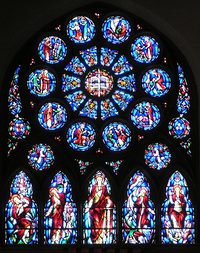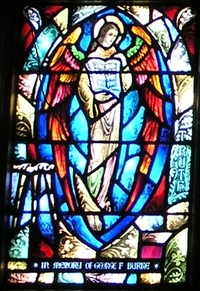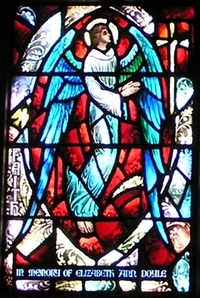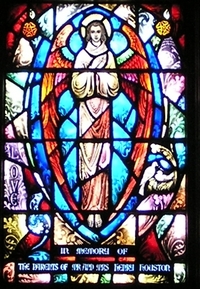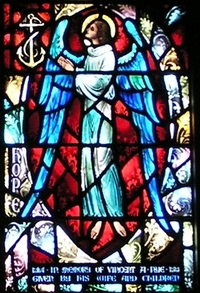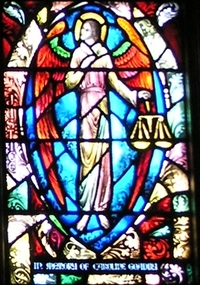Window
Building Name: All Saints Episcopal ChurchStudio Name: Connick (Charles J.), Ltd.
City: Pontiac
Window Shape: 6 (gothic arched, more than 2 vertical sections)
Date of Window: 1952
Subject/Title of Window: St. Paul/The Five Virtues
Brief Description of Subject: Top:
The rise window is devoted to the life of St. Paul, the man whom God called to be the apostle to the Gentiles and transform Christianity from a sect of Judaism to a separate, new world wide faith. The first of the lancets at the bottom of the window, beginning at the left, portrays Paul's conversion. The man who had so zealously persecuted the Christian Church, after his vision on the road to Damascus, became one of the greatest leaders of the Church in all history (Acts 9:1-9).The second lancet shows him preaching in Athens, as described in Acts 17:22ff.
"Athenians, I see how extremely religious you are in every way. For as I went through the city and looked carefully at the objects of your worship, I found among them an altar with the inscription, 'To an unknown God.' What therefore you worship as unknown, this I proclaim to you. The God who made the world and everything in it, he who is Lord of heaven and earth, does not live in shrines made by human hands..."
St. Paul's figure, clothed in ruby and white, is shown in the central lancet. He holds the Sword of the Spirit point down, symbolizing the instrument of his martyrdom. In many windows he is shown holding it up as a symbol of his militant preaching.
The fourth lancet relates one of the episodes which occurred during his voyage to Rome where he was being sent as a prisoner to have his case tried before Ceasar, to which he was entitled as a Roman citizen. On the way the ship was caught in a violent storm and for many days was so pounded that all hope was abandoned. However, Paul had a vision in which an angel told him that 'You must stand before the emperor; and indeed, God has granted safety to all who are sailing with you.' (Acts 27:24). Paul assumed leadership and even though they were shipwrecked in Malta, no one was hurt. The fifth lancet portrays St. Paul in Rome 'proclaiming the kingdom of God and teaching about the Lord Jesus Christ with all boldness and without hindrance.' (Acts 28:31). His imprisonment was of a very mild form, and he was permitted to live in his own house with freedom of movement.
The circles of the rose in the upper window deal with other significatn incidents in St. Paul's life. In the circle at the top left he is shown having his sight restored by Ananias after his conversion (Acts 9:17). The circle at the top right shows Paul and Banabas departing on a missionary journey that was to take them to Cyprus (Acts 13:1-4). Continuing clockwise around the rose, Paul is shown healing the man who could not walk; an act which almost cost him his life (Acts 14:8-20). In the next circle he is depicted restoring Euthchus, a young man who had fallen out of a window, to life (Acts 20:7-12). The following circle portrays an incident which occurred when Paul was shipwrecked on Malta, as indicated in the fourth lancet window. While he was there, he lodged at the home of Publius, whose father he healed.
The next circle relates his conversion of Lydia, a well-to-do business woman who sold dyes at Phillipi (Acts 16:14-15). In the following circle, another episode during the shipwreck on Malta is shown, as related in Acts 28:1-6:
"The natives showed as unusual kindness. Since it had begun to rain and was cold, they kindled a fire and welcomed all of us around it. Paul had gathered a bundle of brushwood and was putting in on the fire, when a viper, driven out by the heat, fastened itself on his hand. When the natives saw the creature hanging from his hand, they said to one another, 'This many must be a murderer; though he has escaped from the sea, justice has not allowed him to live.' He, however, shook off the creature into the fire and suffered no harm. They were expecting him to swell up or drop dead, but after they had waited a long time and saw nothing unusual had happened to him, they changed their minds and began to say that he was a god.
The next circle depicts Paul defending himself before King Agrippa who, after he had listened to Paul's earnest story of his conversion, convictions and missionary work, said cynically, 'Are you so quickly persuading to me to become a Christian?' (Acts 26:28). In the following circle Paul and Silas are shown being beaten at Phillipi before they were thrown into prison. Their crime was casting out the spirit of divination from a slave girl, whose owners were enraged at the loss of income from her fortunetelling! The last circle shows Paul preaching at the synagogue at Antioch where he was at first well received but later presecuted (Acts 13:14-52).
In the center of the rose is Paul's symbol, the open Bible with the words "Spiritus Gladius" inscribed, and behind the Bible a sword. Paul spoke of the Word of God as "the sword of the spirit." Surrounding his symbol are twelve flames, indicating twelve Epistles. Between the circles of the rose are five-pointed stars of heavenly steadfastness. In the two outer tracery members of the window other traditional symbols of Paul are found. The cross shield of faith appears in the tracery member on the left; the three fountains symbolizing his martyrdom on the right. The two circles below the rose portray angels of praise (with the trumpet) and prayer (with the censor). Enriching the lancet windows are white lilies of purity.
"O God, by the preaching of yoru apostle Paul you have caused the light of the Gospel to sine throughout the world: Grant, we pray, that we, having his wonderful conversion in remembrance, may show ourselves thankful to you by following his holy teaching; through Jesus Christ our Lord, who lives and reigns with you, in the unity of the Holy Spirit, one God, now and for ever."
Bottom:
The angelic figures in this narthex window represent five Christian virtues: Truth, Faith, Love, Hope and Justice. The three central biblical virtues of Faith, Love and Hope are mentioned in the New Testament (1 Corinthians 13). At the far left is Truth holding a book; Justice holding a scales is at the far right.
Truth: The messenger of Truth holds an open book upon which is inscribed Jesus' words in John 8:32, 'The Truth shall make you free.' Truth's symbol, rays of light descending from the clouds, appears in the lower left hand side of this panel.
Faith: The Cross, symbol of faith, appears in the upper right hand corner of the second panel, to which the blue robed messenger's face is uplifted. The dove in the left center of the section is symbolic of peacy, purity and the creative power of God through the Holy Spirit. It is reminiscent of our Lord's baptism when he was empowered for ministry:'the Spirit desceneded from Heaven like a dove, and it remaind on Him.' (John 1:32).
Love: The center panel is enriched on either side at the top by a rose of divine lve. The birds at their next suggest God's loving care and protection, bringing to mind Jesus' words in Matthew 6:26, 'Look at the birds of the air; they neither sow nor reap nor gather into barns, and yet your heavenly Father feeds them. Are you not of much more value than they?'
Hope: The heavenly messenger contemplates hope's symbol, the anchor, which appears in the upper left corner of this panel. An anchor is a symbol of steadfastness and constancy; the anchor in Christian art symbolizes the absolute surety of God's salvation through the resurrection of Jesus Christ. As indicated in the notes for the Baptistery, this symbol comes from Hebrews 6:19.
Justice: In the extreme right panel, the scales are the symbol for justice. They are held by a young woman with a blindfold over her eyes; justice is impartial in her decisions. It recalls Peter's words in Acts 10:34, 'I truly understand that God shows no partiality, but in every nation anyone who fears him and does what is right is acceptable to him.'
Inscriptions: In Memory of Vincent A. Nye, Given by his wife and children
In Loving Memory of Clara Phelps Smith
In Memory of George F. Burke
In Memory of Elizabeth Ann Doyle
In Memory of The Parents of Mr. and Mrs. Henry Houston
In Memory of Caroline Goadby
Height: ~333"
Width: ~121"
Type of Glass and Technique: Lead Came
St. Paul
The Five Virtues
Truth
Faith
Love
Hope
Justice
The MSGC is a constantly evolving database. Not all the data that has been collected by volunteers has been sorted and entered. Not every building has been completely documented.
All images in the Index are either born-digital photographs of windows or buildings or are scans of slides, prints, or other published sources. These images have been provided by volunteers and the quality of the material varies widely.
If you have any questions, additions or corrections, or think you can provide better images and are willing to share them, please contact donald20@msu.edu

